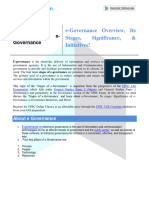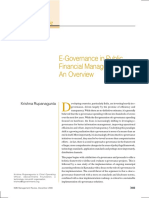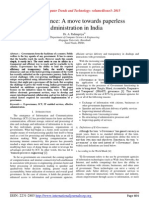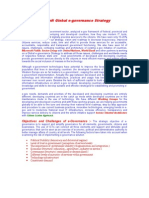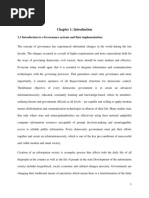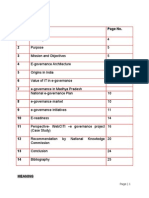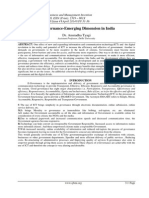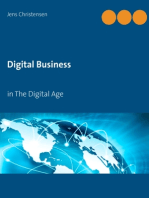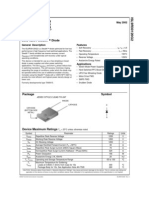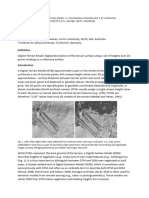E Goverance Chapter VI
E Goverance Chapter VI
Uploaded by
Rahi Digital Services PandharpurCopyright:
Available Formats
E Goverance Chapter VI
E Goverance Chapter VI
Uploaded by
Rahi Digital Services PandharpurOriginal Title
Copyright
Available Formats
Share this document
Did you find this document useful?
Is this content inappropriate?
Copyright:
Available Formats
E Goverance Chapter VI
E Goverance Chapter VI
Uploaded by
Rahi Digital Services PandharpurCopyright:
Available Formats
E- Governance Chapter – VI Performance Management
Chapter VI
Performance Management
E-GOVERNMENT READINESS ASSESSMENT FRAMEWORK
E-government is neutral technology; the Internet became an important infrastructure
for government services. Online government followed the path of business services and private
transactions, which had discovered first the usefulness of the Internet as information
infrastructure. Beyond the Internet, other technologies and applications can be used for e-
government services, such as telephones (fixed or mobile), messaging systems (SMS or MMS),
fax, biometric identification, smart cards, radio-frequency ID (RFID) chips, as well as television
or radio-based government services used to provide disaster warnings, electronic newsletters,
education management systems and traffic control systems.
E-Government is often associated with government web portals because
most governments, national or local, have created web sites and umbrella portals, operating as
gateways and guidance to information and services. Some governments have moved forward by
introducing personalized e-government services that go beyond the provision of general
information to allow case sensitive interaction with the user.
The introduction of e-government applications has been beneficial to
governments in several ways. Most significantly, in the area of public procurement, electronic
applications have expanded government access to potential suppliers and increased the number
of offers received in a timely manner. e-Government applications also provide a valuable
development tool by increasing the effectiveness of aid provision and procurement.
One example is the Aid Management Platform (AMP), created by the
Development Gateway Foundation. This platform provides governments a virtual workspace
where state employees and donors can share aid information online, supporting planning,
execution and implementation activities.
The time and funds required to provide government services can be a
burden to citizens, businesses and to administrations, particularly for those in developing
countries and rural areas. By introducing e-government services, governments can dramatically
reduce transaction costs and improve internal planning mechanisms.
Moreover, the introduction of e-government and the integration of services
usually require governments to streamline their administrative processes. Streamlining improves
efficiency, reduces costs and generates savings, lowering the cost of government services.
New Satara College of BCA Pandharpur 1 Prof. Kirpekar R.R.
E- Governance Chapter – VI Performance Management
In some cases, generated revenues may be used to reduce or abolish service
fees, or can be reinvested into more sophisticated e-government applications and services.
The case of the Indian e-government centre “Jan Seva Kendra”, discussed in
illustrates the effect that re-engineering processes and documenting administrative actions—
activities required for e-government provision—may have in reducing corruption, increasing
transparency and trust in administrations, as well as in facilitating improved citizens’
involvement in government.
Further, e-government can support democratization (e-Democracy) by
enabling citizens to participate in political consultations in real-time and in a cost effective
manner.
These applications also provide the means for politicians to be better
informed about public opinions. Moreover, increasing use of ICTs for social networking is
giving citizens a powerful instrument to influence political processes; increased citizen
involvement through e-government tends to be mirrored by intensified government efforts to
improve transparency and accountability.
Finally, e-government is considered a means to reach national environmental
targets, as it eases the process towards a “paper free office”. Nevertheless, more studies are
needed to evaluate the environmental impact that the implementation of e-government may have
on other areas, such as increased electricity consumption of ICT infrastructure or the disposal
of obsolete equipment, also known as “e-waste”.
Governments use information and communication technologies (ICTs) for the
exchange of information with citizens and businesses on topics such as tax compliance, public
utility services, as well as vehicle and voting registration. Often, the introduction of e-
government services goes along with a change towards a more customer friendly culture.
POTENTIAL BENEFITS OF IMPLEMENTING E-GOVERNMENT
E-government environment to help decision makers identify priority areas for
action, based on their level of readiness and national development strategies. The e-Government
Readiness Assessment Framework aims to assist decision makers from low, lower middle and
upper middle income countries in determining the condition of e-government in their countries;
comparing it to the status of e-government in other economies, and identifying priority areas for
further action. To this end, the framework provides a comprehensive overview of publicly and
freely available data, collected by United Nations agencies, international finance institutions,
New Satara College of BCA Pandharpur 2 Prof. Kirpekar R.R.
E- Governance Chapter – VI Performance Management
business organizations and non-governmental organizations (NGOs), which can be used to
understand the e-government readiness of a country.
The purpose is not to collect new data, but to promote the understanding and use of
existing e-government data collections by calling attention to the aspects they provide
information about, as well as to their strengths and weaknesses. To further facilitate the
assessment of national e-government readiness, the framework includes an “e-Government
Readiness Quick-check Tool”, a hands-on IT-tool, developed by ITU, that assembles data from
five recognized indices and a pragmatic choice of indicators discussed in this framework. The
tool provides a graphical illustration of a country’s readiness status on four dimensions of the e-
government environment: Infrastructure, policy, governance and outreach.
Finally, based on the analysis of available data and a review of relevant
literature, this framework suggests topics to be examined in future Toolkit modules and indicates
the topics that might be most relevant to a country, according to its income level classification.
Once all the modules have been completed, with the input of ITU’s membership, this
introduction will be reviewed to reflect the final structure of the Toolkit.
New Satara College of BCA Pandharpur 3 Prof. Kirpekar R.R.
You might also like
- Minex Modelling Flow ChartDocument6 pagesMinex Modelling Flow ChartDadan50% (2)
- E-Governance Concept andDocument13 pagesE-Governance Concept andmail2liyakhatNo ratings yet
- E GovernanceDocument31 pagesE GovernanceNashiba Mastura50% (2)
- 4.8.2 - Game Architecture and DesignDocument2 pages4.8.2 - Game Architecture and DesignPranil NandeshwarNo ratings yet
- The E-Governance Architecture of Global ICT Program: Saman Mujtava and Dr. Prashant Kumar PandeyDocument5 pagesThe E-Governance Architecture of Global ICT Program: Saman Mujtava and Dr. Prashant Kumar PandeyAyushi AroraNo ratings yet
- "Reaching The Unreached"VDocument13 pages"Reaching The Unreached"VsanjarrahmanNo ratings yet
- Role of Information Technology in GovernanceDocument6 pagesRole of Information Technology in Governanceprabh17No ratings yet
- E Governance ModelDocument13 pagesE Governance Modelrohit87280No ratings yet
- ARC 11th Promoting E GovernanceDocument21 pagesARC 11th Promoting E GovernanceajaiswalcoolNo ratings yet
- E-Commerce - unit-IIIDocument28 pagesE-Commerce - unit-IIIajjugamer171No ratings yet
- E Governance in IndiaDocument12 pagesE Governance in IndiaSiddharthJainNo ratings yet
- Design & Development of E-Governance Model Sheela Priya & R.Radhakrishnan, M.E, PH.DDocument3 pagesDesign & Development of E-Governance Model Sheela Priya & R.Radhakrishnan, M.E, PH.DDivyam DhamejaNo ratings yet
- MIS Group AssignmentDocument12 pagesMIS Group AssignmentAbnet BeleteNo ratings yet
- E-Governance in India: International Journal of Computing & Business Research ISSN (Online) : 2229-6166Document12 pagesE-Governance in India: International Journal of Computing & Business Research ISSN (Online) : 2229-6166Deep SanNo ratings yet
- 11th e Governance 1Document21 pages11th e Governance 1Vishal VermaNo ratings yet
- Governance in IndiaDocument13 pagesGovernance in IndiaharikumaranNo ratings yet
- E - Governance - Concept & SignificanceDocument6 pagesE - Governance - Concept & SignificanceErwin AcedilloNo ratings yet
- Ak Chapter 1Document17 pagesAk Chapter 1Bhagat SinghNo ratings yet
- E-Governance: Project Report ONDocument17 pagesE-Governance: Project Report ONVishal ChoudharyNo ratings yet
- Role of Government:: As An Enabler, Regulator, and Provider of ICT Based ServicesDocument11 pagesRole of Government:: As An Enabler, Regulator, and Provider of ICT Based ServicesGangesh MayankNo ratings yet
- Stages of e Governance f50432f9Document10 pagesStages of e Governance f50432f9chaitali.chatterjee12345No ratings yet
- E-Government - The Case of The Gambia - UNECA Briefing PaperDocument4 pagesE-Government - The Case of The Gambia - UNECA Briefing PaperAddislilyNo ratings yet
- New Microsoft Office Word DocumentDocument2 pagesNew Microsoft Office Word DocumentjubbalchaitalieNo ratings yet
- SSB Advertisement 001.2015Document11 pagesSSB Advertisement 001.2015Chandrika DasNo ratings yet
- E-Governance: A Move Towards Paperless Administration in IndiaDocument8 pagesE-Governance: A Move Towards Paperless Administration in IndiaseventhsensegroupNo ratings yet
- Name: Shoyshob Ahammed Shonchoy ID: 19-39796-1 COURSE: E-Governance Section: ADocument4 pagesName: Shoyshob Ahammed Shonchoy ID: 19-39796-1 COURSE: E-Governance Section: Ashonchoy ahammedNo ratings yet
- 1 Introduction to E-GovernanceDocument52 pages1 Introduction to E-GovernanceSurya BasnetNo ratings yet
- E Governance UPSC NotesDocument5 pagesE Governance UPSC NotesranbirkhanNo ratings yet
- Unit 1 IntroductionDocument10 pagesUnit 1 IntroductionYadav RimalNo ratings yet
- all-E-systemDocument12 pagesall-E-systemAli BallahNo ratings yet
- E Governance ARC SummaryDocument14 pagesE Governance ARC SummaryGurNihal BrarNo ratings yet
- Microsoft Global E-Governance Strategy: Microsoft Public Sector Group United Nations, World BankDocument8 pagesMicrosoft Global E-Governance Strategy: Microsoft Public Sector Group United Nations, World Bankapi-23018863No ratings yet
- MPA017Document209 pagesMPA017Aviral PandeyNo ratings yet
- E GovernanceDocument13 pagesE Governancemehak sraNo ratings yet
- Technological Risks in Developing E Governance ProjectsDocument5 pagesTechnological Risks in Developing E Governance ProjectsEditor IJRITCCNo ratings yet
- KM Lecture 1 3Document12 pagesKM Lecture 1 3kyluhveronica23No ratings yet
- 2nd ARC Promoting - e - GovernanceDocument94 pages2nd ARC Promoting - e - GovernancerhinocharmersNo ratings yet
- Chapter-1 IntroductionDocument12 pagesChapter-1 IntroductionspartenzsmpNo ratings yet
- Governance - by Sahiba MehtaDocument5 pagesGovernance - by Sahiba MehtaAlpana VarnwalNo ratings yet
- MIS in E-GovernmentDocument6 pagesMIS in E-GovernmentHamza parwaniNo ratings yet
- History and Development of E-Governance: Chapter - IiiDocument12 pagesHistory and Development of E-Governance: Chapter - Iiia0mittal7No ratings yet
- Information Technology LAW Project Report ON E-GovernanceDocument21 pagesInformation Technology LAW Project Report ON E-GovernancekartikNo ratings yet
- Role of Information Technology in GovernanceDocument7 pagesRole of Information Technology in GovernanceFurqhanMalik67% (3)
- E GovernanceDocument9 pagesE GovernanceAkhilesh SingaramNo ratings yet
- E Government PDFDocument3 pagesE Government PDFJessie LibosadaNo ratings yet
- MIS Is That The Use of Knowledge TechnologyDocument7 pagesMIS Is That The Use of Knowledge TechnologyParesh AglaveNo ratings yet
- Result_22_12_2023, 19_23_50Document12 pagesResult_22_12_2023, 19_23_50vaishchaudhary27No ratings yet
- Lecture Digital - GovernanceDocument37 pagesLecture Digital - Governancepoonamsingh5874No ratings yet
- E Goverence1Document43 pagesE Goverence1NitinAgnihotri100% (1)
- 950pm - 10.EPRA JOURNALS 14335Document4 pages950pm - 10.EPRA JOURNALS 14335Akhilesh roshanNo ratings yet
- bbbbbbbDocument9 pagesbbbbbbbAhmadzadeNo ratings yet
- IT AssignmentDocument24 pagesIT AssignmentAkshat GuptaNo ratings yet
- E Government AdoptionDocument24 pagesE Government AdoptionEzekiel Ogakhan Nyamu100% (1)
- E-Governance-Emerging Dimension in India: Dr. Anuradha TyagiDocument6 pagesE-Governance-Emerging Dimension in India: Dr. Anuradha TyagiinventionjournalsNo ratings yet
- 1 PBDocument10 pages1 PBAbdul ManafNo ratings yet
- Meaning and Importance of E-GovernanceDocument13 pagesMeaning and Importance of E-Governanceshivam mishraNo ratings yet
- Tool Kit for Tax Administration Management Information SystemFrom EverandTool Kit for Tax Administration Management Information SystemRating: 1 out of 5 stars1/5 (1)
- Digitizing Government: Understanding and Implementing New Digital Business ModelsFrom EverandDigitizing Government: Understanding and Implementing New Digital Business ModelsNo ratings yet
- Delivering on Digital: The Innovators and Technologies That Are Transforming GovernmentFrom EverandDelivering on Digital: The Innovators and Technologies That Are Transforming GovernmentNo ratings yet
- ERP ImplementationDocument8 pagesERP ImplementationRahi Digital Services PandharpurNo ratings yet
- Erp PackagesDocument3 pagesErp PackagesRahi Digital Services PandharpurNo ratings yet
- E Goverance Chapter VDocument5 pagesE Goverance Chapter VRahi Digital Services PandharpurNo ratings yet
- E Goverance Chapter VIIDocument5 pagesE Goverance Chapter VIIRahi Digital Services PandharpurNo ratings yet
- Chpter IDocument16 pagesChpter IRahi Digital Services PandharpurNo ratings yet
- Module4.2 PM Create N1 Notification ZIW21 24.02.2013 V1.0Document28 pagesModule4.2 PM Create N1 Notification ZIW21 24.02.2013 V1.0pganoelNo ratings yet
- Peoplexploit DevDocument29 pagesPeoplexploit Dev014 CSE Devamruth AGNo ratings yet
- Strategic Surprise: DSB Summer Study Report OnDocument22 pagesStrategic Surprise: DSB Summer Study Report OnIolanda EneNo ratings yet
- R30120G2Document6 pagesR30120G2Israel Osornio LeonNo ratings yet
- Home AutomationDocument56 pagesHome AutomationDevdatta Supnekar67% (3)
- 8614 - Assignment 2 Solved (AG)Document19 pages8614 - Assignment 2 Solved (AG)Maria GillaniNo ratings yet
- DMW MergedDocument454 pagesDMW MergedTECOA136TejasJadhavNo ratings yet
- Audi Bluetooth Adapter 4F0 051 510J InstructionsDocument8 pagesAudi Bluetooth Adapter 4F0 051 510J Instructionssysrq0000No ratings yet
- Unit-2 (Part-A) Notes of OOP (KOE-064) Subject by Updesh Jaiswal Given To Students at AKGECDocument8 pagesUnit-2 (Part-A) Notes of OOP (KOE-064) Subject by Updesh Jaiswal Given To Students at AKGECviku9267No ratings yet
- Sample Process Guide - Configuration ManagementDocument50 pagesSample Process Guide - Configuration ManagementZunair Jawaid100% (1)
- Scripting Tracker: Hint: If The SAPDocument140 pagesScripting Tracker: Hint: If The SAPAlessandra ReclaNo ratings yet
- DTM SourceDocument6 pagesDTM SourceHand YoungNo ratings yet
- Project Management OverviewDocument32 pagesProject Management OverviewCynthia FreskyNo ratings yet
- Credit Card Fraud Detection Using A Combined Approach of Genetic Algorithm and Random ForestDocument4 pagesCredit Card Fraud Detection Using A Combined Approach of Genetic Algorithm and Random ForestEditor IJTSRDNo ratings yet
- Electrical Point MatrixDocument1 pageElectrical Point MatrixPalaniyandiNo ratings yet
- Simultaneous Equations 3 VariablesDocument4 pagesSimultaneous Equations 3 VariablesCaroliny Jeti100% (1)
- MCQs SQL ServerDocument15 pagesMCQs SQL ServerAtif JanNo ratings yet
- FlashSystem 7300 ENGDocument12 pagesFlashSystem 7300 ENGJuan Pablo PerezNo ratings yet
- Consent Form For Parents To Generate Apaar IdDocument1 pageConsent Form For Parents To Generate Apaar Idbakkarabu7933No ratings yet
- HS MS MSX RS232 Protocol 20140822 After Current UpgradeDocument21 pagesHS MS MSX RS232 Protocol 20140822 After Current UpgradeMohamed MourtagaNo ratings yet
- TCS CodeVita PreparationDocument3 pagesTCS CodeVita Preparationgfake6405No ratings yet
- Student enDocument5 pagesStudent envgarciaNo ratings yet
- Division of Pampanga: One Deped One PampangaDocument12 pagesDivision of Pampanga: One Deped One PampangaNorman Laxamana SantosNo ratings yet
- cs3401 - ALGORITHM LAB MANUALDocument8 pagescs3401 - ALGORITHM LAB MANUALebinezer.jhonsonNo ratings yet
- RM 2019 1 Pag 04 HongDocument4 pagesRM 2019 1 Pag 04 HongLê TrungNo ratings yet
- Schneider Electric List Prices Sub-Collection 8 Segment Applications June 2022 V1 enDocument948 pagesSchneider Electric List Prices Sub-Collection 8 Segment Applications June 2022 V1 enSidali Hadj BenaliNo ratings yet
- Oracle® Essbase Integration Services: System Administrator'S GuideDocument242 pagesOracle® Essbase Integration Services: System Administrator'S GuideVikas NaiduNo ratings yet





















